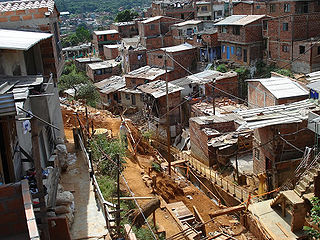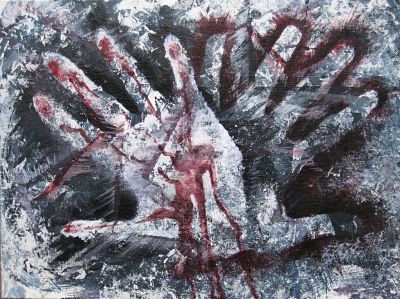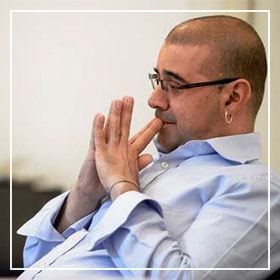I want to begin with Julia´s history, an indigenous woman from the South of Colombia who currently lives in one of Bogotá’s massive shantytowns. Her life speaks of a series of tragic events that address not only the immediate and devastating effects of war but also, more subtly, the ways in which certain forms of violence, what I call historical injuries, are rendered unintelligible by mainstream, official legal-technocratic discourses in post-war countries (Castillejo, 2013). These sketchy notes are part of a larger ethnographic project that seeks to unpack the connections between “violence”, “temporality”, and the “law” in different “transitional scenarios” and explore how laws of national unity and reconciliation “articulate” limited conceptions of “violence” as well as conceive the prospect of an imagined new future.[2] I take Julia´s history as a way to pose a more general question about the unintelligibility of collective suffering.
The following is an excerpt from my fieldnotes:
Julia is a married woman. She initially had two children: Paula is sixteen years old. León, a bit older, suffers from leukemia. Several years ago (when she was 27) Julia and her daughter (then only five years old) were raped by paramilitaries. Of Julia´s rape, a third child was born. Clara is now 12 years old. Julia feels, as could be expected, all kinds of ambiguities regarding her little one, who reminds her of the abuse her body suffered. At one point, out of desperation, Julia thought of aborting Clara. For Julia, with Clara’s birth, life and death existentially coexisted. The baby was, in more than one sense, an unwanted human being. In addition to this tragedy, her son suffers from an incurable disease. In a different manner, in his body, life and death also coexist. At one point, Julia finally runs away because the rapist threatened her after she took the case to the police. The police, illegally, warned the perpetrator on the situation. At that moment, she did not know she was pregnant. Julia then abandoned her husband and moved to the dusty southern outskirts of Bogotá’s localidades that surround the hilly landscape. She lives, as a forcefully displaced woman, in a tiny, hidden space and feeds her children, like many other indigenous people on the streets of the city, by selling cigarettes on an urban bus at 10 cents each (dollar price). Eventually, her husband found her and discovered she had delivered a child, Clara. In time, he embraced the little one as one of his own. Julia lives today in abject, chronic poverty and historically conditioned hunger. During a subsequent conversation I had with a close friend, my interlocutor concluded laconically about Julia´s situation: “the problem in Colombia” [despite all the rhetoric of reparations of the Justice and Peace Law], paradoxically, “is that the State has no way “to repair” this indigenous woman’s life, there is no mechanism to repair this person’s life.”
Last time I asked about Julia, I was told that her sick youngster was now into drugs and gangs. “It seems she decided to return to the South,” her friend said. Yet “it looks like,” due to lack of resources and fear, “she hasn’t been able to do so,” she conceded.[3]
 I want to highlight two different registers in the presiding excerpt. I am interested in Julia´s personal history, on the one hand, and on her friend´s appreciation of Julia´s life, on the other. First of all, Julia´s experience is an example of the sexualized power exerted over an indigenous woman by men carrying guns, an example of her body taken quite literally as a territory of war, and of the person’s subjectivity and dislocation as a battle trophy in the context of “armed conflict.” A large body of academic work attests to this gendered violence and the difficulties in testifying to it. In this context, during times of “transitions” states do have legal and institutional mechanisms to deal with this kind of abuse.
I want to highlight two different registers in the presiding excerpt. I am interested in Julia´s personal history, on the one hand, and on her friend´s appreciation of Julia´s life, on the other. First of all, Julia´s experience is an example of the sexualized power exerted over an indigenous woman by men carrying guns, an example of her body taken quite literally as a territory of war, and of the person’s subjectivity and dislocation as a battle trophy in the context of “armed conflict.” A large body of academic work attests to this gendered violence and the difficulties in testifying to it. In this context, during times of “transitions” states do have legal and institutional mechanisms to deal with this kind of abuse.
However, and this is the second point I would like to raise, her situation is also the product of a larger cultural history, a wider temporality that exceeds current conceptualizations and legal-technocratic approaches in vogue in transitional scenarios. Hers is the history of exclusion and chronic, historical inequality of indigenous communities in Colombia. Her body is a repository of this palimpsest.
In this case, violence is the product of overlapping “inequality” and “difference.”
In other words, Julia inhabits a form of victimization that, however immediate and concrete, falls also beyond the “legal epistemologies” that inform global debates on transitional justice, more concerned with recent histories of abuse. Her experience speaks more of forms of violence that are not conceived (within certain theoretical frames) as such, and therefore cannot be “repaired” — either because they are situated in a far-off, neutralized past (the formal colonial past or the slave past, for example) or because they are at one point subtly dressed with the robes of “national unity and reconciliation” that compel a society to “look to the future”, to “turn the page”, to “leave the past behind,” and to forgive and reconcile in a “post-violence,” “post-conflict” society. However, bodies and subjectivities like the one of Julia, crushed by the daily carvings of permanent and systemic lack, remind us of an ever-present past as well as of the limitations of these discourses.
In short, her personal history is that of an indigenous woman living in a situation of chronic misery. In part, the tragedy was not only sexual abuse (with all the destruction this conveys), but also the historical, structural, and material conditions that allow (and have allowed) the abuse to happen in the first place, despite important legal developments since the 1991 Constitution in Colombia. In this sense, the kinds of violence she embodies are so multifarious, localized in both, a set of multiple “spaces” —geographical, bodily, subjective, and existential ones— and temporalities (simultaneously in the “historical past” and in “the present”). The reference to a potential impossibility of “repairing” Julia, as the interlocutor alluded to, bears the question as to the multiple registers of pain and injury that are entwined with the present. [4]
More precisely, how are historical injuries repaired? Do laws of national unity and reconciliation address such issues or are they structurally unable to address them?
Furthermore, might it be possible to speak of harm as an accumulative phenomenon (even over centuries), a kind of existential palimpsest in which layers of collective suffering entwine? In other words, violence has been and continues to be part of the social experience. For indigenous organizations not only in Colombia but also in other “post-war” countries (Guatemala, Salvador or South Africa), if it has any meaning, the notion of “transition” is experienced as a kind of continuity rather than as break with the past.
As I argued elsewhere in more detail, the idea of “transitional justice” (and the complex network of legal and extralegal mechanisms in charge of “dealing with” the causes and effects of human rights violations) is based on at least two basic assumptions. On the one hand, it is grounded on the “promise” and the prospect of an imagined new nation. And secondly, it is also grounded on the very possibility of assigning violence (defined in very particular ways) a place “behind,” in the aseptic isolation of “the past.” In other words, as societies move “forward” (a “movement” reflected in the application of “constitutional reforms,” “memory initiatives,” “reparation programs,” “development projects,” “economic reforms,” among other “social repair initiatives”) violence is “left” and “locked” behind (Castillejo 2014)
 In most cases, the notion of “transition,” or “countries in transition,” implies a teleological movement from “authoritarian rule” (or “internal armed conflict” and mass atrocities) towards a “liberal democracy” inserted in today’s global Capitalism. In reality, however, the “transitionparadigm” is now applied to many other historical experiences that are not necessarily described as “post-authoritarian”. The global gospel of forgiveness and reconciliation, and indeed its inherent technologies of transition, is part of a larger discursive framework through which this teleological movement takes place.
In most cases, the notion of “transition,” or “countries in transition,” implies a teleological movement from “authoritarian rule” (or “internal armed conflict” and mass atrocities) towards a “liberal democracy” inserted in today’s global Capitalism. In reality, however, the “transitionparadigm” is now applied to many other historical experiences that are not necessarily described as “post-authoritarian”. The global gospel of forgiveness and reconciliation, and indeed its inherent technologies of transition, is part of a larger discursive framework through which this teleological movement takes place.
However, in countries where structural, long-standing political and economic inequalities have structured everyday life, is it possible to think of “transitions” as a kind of continuity with the past rather than as a rupture in which they are often presented? How could these continuities be identified and how do they determine the fate of politics in the present?
In the end, how is chronic hunger and historical injury “healed”? In places where profound social inequalities remain to be abysmal, how can a sustainable peace be accomplished if the historical and structural causes of internal conflict remain to be resolved? Forms of violence in which difference and inequality —despite the promise of the newness— are still woven together into a longue durée, that lay beyond, so to speak, the theoretical contours and the technical mandates (as well as the “trauma” and “human rights” tropes) defined by and inherent to laws of national unity. Could this fact be the seeds of future conflicts? It seems to me that it is in part up to anthropologists to unveil the colonial heritage of transitional mechanisms as they have been articulated with broader, global legal frameworks. Perhaps, the project of unpacking these continuities amounts to the need of decolonizing transitional justice theories and practices.
Footnotes
[1] Head of Department, Department of Anthropology, Universidad de los Andes, Colombia acastill@uniandes.edu.co
[2] I use the term transitional scenario to refer to the assemblage of globally interrelated discourses, expert knowledges, and institutional practices put in place by what I generically call laws of national unity and reconciliation in order to face the effects of gross violations of human rights. I refer to these technologies of transitions as a global gospel of forgiveness and reconciliation (Castillejo, 2007).
[3] Quoted with Julia´s permission. I thank Natalia Camacho for her help and timely corrections. All names have been changed.
[4] I use the term “to repair” (verb), as translated literally from the Spanish word “reparar”, which has a slightly mechanical connotation: to repair a car or a broken object. The other important term is “daño” (“injury”, “harm”, “damage” in their multi-layered existential, legal, and psychological registers).In Colombia much of the social debate around violence deals with “repairing” (or “reconstructing”) the damage done to the “social fabric” (tejido social) by armed conflict or by “violence”. This injury can be “individual” or “collective”, although the collective nature of injury (strongly evoked by the term tejido social) is more evasive and difficult to grasp.
References
Castillejo-Cuéllar, Alejandro
______. 2014. “Historical injury, temporality and the law: Articulations of a violent past in two transitional scenarios” Law and Critique 25 (In press)
______. 2013. “On the Question of Historical Injuries: Anthropology, Transitional Justice and the Vicissitudes of Listening” Anthropology Today 29(1): 16-19
______. 2007. “Knowledge, Experience and South Africa’s Scenarios of Forgiveness.” Radical History Review 97 (winter): 1-32






